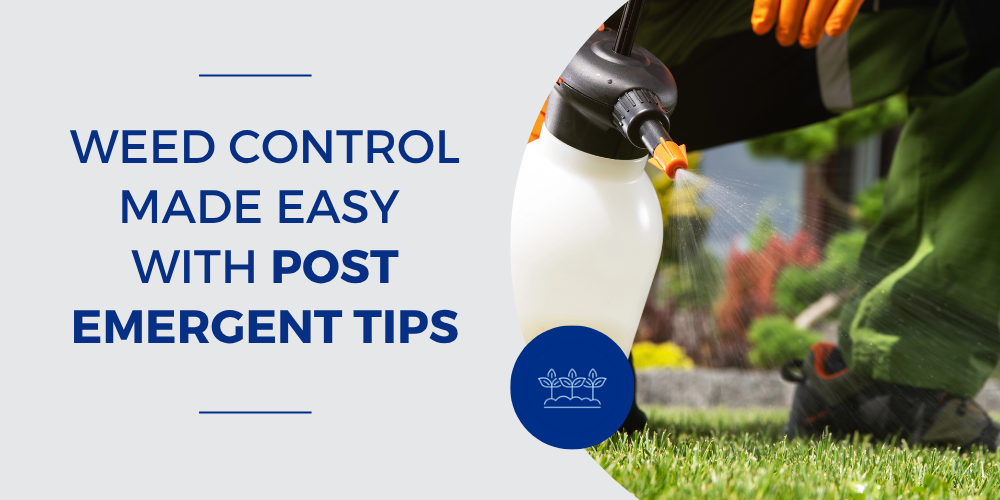A few overlooked weeds can easily take hold during spring and become a full-blown problem by summer. Knowing how to use post-emergent herbicides effectively can make all the difference. While applying a pre-emergent is a great first line of defense, some persistent weeds may still break through. That’s where post-emergents step in. If you’re starting to see unwanted growth, now’s the time to act. In this blog, we’ll walk you through the best practices for using post-emergent herbicides to keep your lawn and garden looking their best.
What are Post-Emergent Herbicides?
Post-emergent herbicides are designed to kill existing weeds after they have sprouted and become visible above ground. These herbicides are applied to actively growing weeds and target their foliage or systemic pathways to disrupt growth and ultimately kill the plant. Unlike pre-emergent herbicides, which prevent germination, post-emergent herbicides are used to manage weeds that are actively growing. There are two main types:
Selective Post-Emergents target specific weeds, such as dandelions or crabgrass, without harming your lawn or other nearby plants.
Non-Selective Post-Emergents kill any plant they come into contact with — this type is ideal for driveways, sidewalks or total renovation zones.
When to Use Post-Emergent Herbicides?
The best time to apply post-emergent herbicides depends on what type of weed you are dealing with, but some general rules are:
Wait for Visible Growth — Post-emergents only work on actively growing weeds, so wait until you can see them before applying.
Apply During Warm, Calm Weather — Mid to late spring through early fall is ideal. Aim for a dry day and ensure there is no rain in the forecast for at least 24 hours.
Avoid Mowing Before or Right After Spraying — Give the plant time to absorb the product. Wait a few days on either side of mowing for the best results.
Where are the Weeds?
Next, determine what type of terrain needs the treatment. Different terrain means different application techniques. The most common application areas are gravel and grass.
Gravel Areas:
Weed Growth: Weeds in gravel often grow through cracks, crevices or directly in the gravel itself, especially if there is underlying soil or debris.
Post-Emergent Application: Post-emergent herbicides are effective for killing existing weeds in gravel. They are a good choice when weeds are already visible.
Application: Apply directly to weeds. When applying a non-selective post emergent, be careful not to spray any nearby desirable plants.
Limitations: Post-emergents kill existing weeds but do not prevent new ones from growing
Prevention: Consider using a geotextile fabric beneath the gravel to act as a barrier.
Grass Areas:
Weed Growth: Weeds in lawns compete with grass for resources like water and sunlight
Post-Emergent Application: Use a selective post-emergent that targets specific types of weeds while leaving the grass unharmed
Application: Apply post-emergent when the weeds are actively growing, ideally in late spring and early fall.
Post-Application: Water treated area as instructed by the product label.
How to Apply Post-Emergents Like a Pro
Identify Your Weeds
Broadleaf or grassy? Annual or perennial? Knowing which type of weed you’re targeting will help you pick the right product.
Choose the right formula
Liquid sprays are great for spot treatments. Granules work better for larger infestations.
Read the Label
Always thoroughly read any labels and instructions for safe and effective use.
Spray with Precision
Use a sprayer for even coverage and avoid accidental contact with desirable plants. Wear full coverage clothing and protective gear to keep yourself safe.
Be Patient
Depending on the product and plant type, post-emergents can take anywhere from a few days to a few weeks to fully kill weeds.
Common Mistakes to Avoid
Spraying when it is too hot or cold — Extreme temperatures can reduce effectiveness
Overapplying — More is not better. Stick to the instructions on the herbicide and only use the recommended amount to avoid harming your soil or lawn.
Ignoring new growth — Some weeds will need follow-up treatments. Keep an eye out and reapply if necessary.
As you prep your yard for summer festivities, swing by one of our Valley-wide Bug & Weed Mart locations for expert advice and DIY weed control products. Whether you’ve spotted a few aggravating stray weeds or you are dealing with full-on overgrowth, our knowledgeable team is here to help you choose the right products and form a foolproof strategy. We’ll guide you through how to apply solutions correctly, when to reapply and how to pair with other solutions for long-term control.

